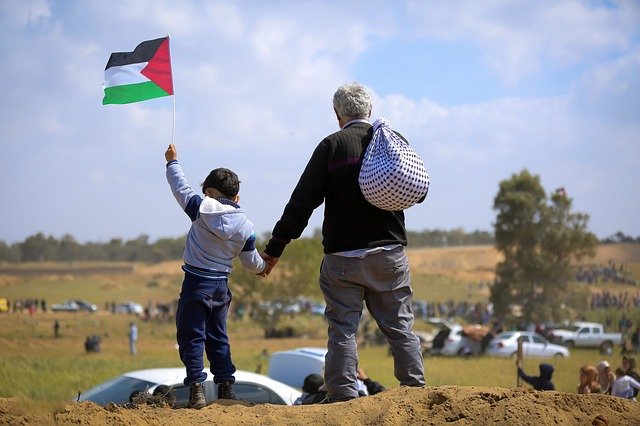The Status of Palestinian Refugees in International and EU Law: A Very Brief Overview
Dimitra Fragkou[1]
Abstract:
A common misconception is that all refugees worldwide fall under the Provisions of the 1951 UN Convention relating to the Status of Refugees (Refugee Convention). The present blog post will explore how this is not the case when referring to Palestinian refugees, briefly revisiting a) the events that led to the massive displacement of Palestinians, b) the undertaken measures to assist Palestinian Refugees under UNWRA Mandate, c) the scope of Article 1(D) of the Refugee Convention and d) how it has been interpreted within the Common European Asylum System (CEAS).
Keywords: Palestinian refugees, Refugee Convention, exclusion, UNRWA, CEAS
1. Fleeing the ‘longest military occupation in modern history.’
The history of the division of Palestine is far earlier than the beginning of the Arab – Israeli conflict in 1967 and is premised to -for some authors- a very pragmatic reason, the existence of one land for two nations.[2] Palestinian refugees exist officially before the adoption of the Refugee Convention. Following the end of World War I, the territories occupied by the Entente Powers came provisionally under the temporary administration of each of the winners and then under the League of Nations Mandate system. The former Ottoman territories of Palestine and Transjordan were merged under the British administration as the Mandate of Palestine, lasting from 1922 to 1948. During the war, Britain sought to establish alliances with different groups in the region via agreements of prospective self-determination, including creating a Jewish state (Balfour declaration – 1917).[3]
The British rule was handed over to the United Nations in 1946, and soon after, on 29 November 1947, Resolution 181(II)[4] was adopted, providing for the creation of two separate states in the region and the recognition of Jerusalem as an international city.[5] The plan escalated the already existing tensions between the Arab and the Jewish population in the area. By the Israeli State declaration of independence, on 14 May 1948, a war -referred to as al-Nakba (the Catastrophe)- erupted with the neighbouring Arab states – Egypt, Jordan, Lebanon and Syria, leading to the massive displacement of about 750.000 Palestinians.[6]
Constant clashes followed Al-Nakba. During the Six-Day War of 1967, Israel occupied the West Bank, Gaza, East Jerusalem, the Syrian Golan Heights, and the Egyptian Sinai. Except for the latter, which was returned to Egypt in 1975,[7] the rest of the areas are still occupied by Israel[8] under the ‘longest-sustained military occupation in modern history.’[9] Specifically, the Gaza Strip has been for more than ten years at air, territory, and naval blockade.[10]
Following the eruption of the Syrian conflict ten years ago, the secondary displacement of Palestinian refugees residing in Syria came again under the microscope. The new clashes in Gaza and the expulsions of the Arab population of East Jerusalem are a painful reminder of a too-long unresolved matter.
2. UNRWA
The number of the Palestinians who fled during and shortly after 1967 is vaguely estimated between 300,000 to 400,000. [11] The number of those forced to migrate since, due to occupation-induced violence, such as deportations,[12] destruction of housing,[13] repeal of residency, the Separation Barrier,[14] is relatively unknown. Despite granting citizenship by certain neighbouring states such as Jordan, many Palestinians are still considered stateless.[15] Officially, as of the end of 2019, Palestinian refugees registered with United Nations Relief and Works Agency for Palestine Refugees in the Near East [UNRWA] were more than 5,6 million.[16]
UNWRA is a subsidiary organ of the UN General Assembly[17] and was founded under Resolution 302(IV) of 8 December 1949.[18] The UNRWA definition of the Palestinian refugee has deliberately remained adaptable due to the complexity of the conflict. UNRWA’s initial mandate, though, determined as beneficiaries:
‘persons whose normal place of residence was Palestine during the period 1 June 1946 to 15 May 1948, and who lost both home and means of livelihood as a result of the 1948 conflict. Palestine Refugees, and descendants of Palestine refugee males, including legally adopted children, are eligible to register for UNRWA services.’ [19]
The mandate extended in the aftermath of the Six-Day War of 1967 to persons displaced by the hostilities, [20] including ‘non-registered persons’. After the invasion of Israel in Lebanon in 1982 and the 2006 hostilities in Lebanon and the Gaza strip, subsequent resolutions broadened further UNRWA’s Mandate. In 2006, the mandate included the family members of Palestinian refugee women whose husbands were not refugees.[21] UNRWA’s current operations are established in Jordan, Lebanon, the Syrian Arab Republic, West Bank, and the Gaza Strip.[22]
The services provided to those registered with UNRWA[23] relate mainly to education, health, relief and social services, infrastructure and camp improvement, and emergency assistance,[24] while programmes of microfinance and microenterprise are noted as successful.[25]
3. The Palestinian Refugees and the Refugee Convention.
UNRWA was established before the adoption of the Refugee Convention in 1951. Therefore, in principle, refugees registered with UNRWA are excluded from the scope of the Refugee Convention and cannot receive the services of UNHCR, as stated in Art. 1(D):
‘This Convention shall not apply to persons who are at present receiving from organs or agencies of the United Nations other than the United Nations High Commissioner for Refugees protection or assistance.
When such protection or assistance has ceased for any reason, without the position of such persons being definitively settled in accordance with the relevant resolutions adopted by the General Assembly of the United Nations, these persons shall ipso facto be entitled to the benefits of this Convention.’[26]
The rationale behind this distinction of Palestinian refugees from other refugees lies in the Refugee Convention’s initial purpose. The Convention was drafted mainly bearing in mind the displaced populations of World War II Europe,[27] whereas the displaced populations in the Middle East were considered completely different.[28] Arguably, the distinction was that in contrast to the Refugee Convention, which safeguarded the right to not return in the country of origin –non-refoulement, Palestinian refugees demanded precisely the opposite – to return. Moreover, UNRWA’s mandate is temporary and is renewed until the resolution of the situation of the Palestinian refugees. As such, the protection may cease if its mandate is not renewed, whereas UNHCR, operating under a multilateral treaty, has, after the adoption of the 1967 Protocol, a universal and permanent scope.[29]
Despite the wish of the drafters, especially for the last sentence of Art. 1(D) to safeguard the rights of Palestinian refugees, relevant state practice has been erratic through the years. Certain states immediately granted asylum to all Palestinians outside of UNRWA’s territory of operation.[30] Others found an opportunity to deny asylum to Palestinian refugees based on the same Article for various reasons, claiming, for example, that Palestinian refugees could be granted asylum only in case of the cessation of UNRWA’s operations or that only those fleeing the 1948 war are eligible ipso facto.[31]
4. The Palestinian Refugees and the Common European Asylum System
The 2004 Qualification Directive, being part of the first generation of CEAS legal instruments, transposed Art. 1(D) of the Refugee Convention in the EU law with Art.12(1)(a). The provision was repeated unaltered in the 2013 Recast Qualification Directive (QD) and is still applicable today. According to the European Commission, Art. 12(1)(a) was drafted ‘within the particular context of refugees from the Palestinian territories.’[32]
Some EU Member States, such as Hungary, followed an interpretation that excluded Palestinian refugees suffering from secondary displacement from international protection. In both the cases of Bolbol (2010) and El-Kott et al. v. Hungary (2012), [33] refugee status was denied to secondarily displaced Palestinians for falling under the scope of Article 1(D) of the Refugee Convention.
In the Bolbol case, the matter at hand was whether the statement’ receiving protection or assistance from other UN organs,’ in this case UNRWA, referred to the mere eligibility of a person to receive assistance (broad interpretation), or on the contrary, he/she should actually have received assistance by UNRWA (narrow interpretation).[34] The applicant claimed that whenever a beneficiary ‘resides […] outside UNRWA’s base of operations, and, for [a] good reason, cannot be expected to return there’[35] comes automatically under the protection of the Refugee Convention. As such, it may be argued that Art. 1(D) constitutes an exceptional ground for granting international protection.[36] The defendant State argued that since Ms Bolbol did not leave her country for any of the refugee grounds provided in the Refugee Convention, her request should be rejected.
Moreover, ‘Art. 1(D) does not automatically grant a basis for refugee status but is merely a provision concerning the Convention’s scope ratione personae. Therefore, Palestinians are entitled to refugee status only where they meet the definition of ‘refugee’ within the meaning of Article 1A of the Geneva Convention, which must be determined on a case-by-case basis.’[37] The Court concluded that ‘only those persons who have actually availed themselves of the assistance provided by UNRWA come within the clause excluding refugee status set out therein, which must, as such, be construed narrowly and cannot therefore also cover persons who are or have been eligible to receive protection or assistance from that agency.’[38]
In the El Kott et al. case, the Court reiterated the Bolbol judgment[39] stating that receiving protection or assistance from [URNWA], ‘cannot be construed as meaning that mere absence or voluntary departure from UNRWA’s area of operations would be sufficient to end the exclusion from refugee status laid down in that provision.’ Such an interpretation would deprive ‘that ground for exclusion of any practical effect.’[40] However, for a Palestinian refugee who is forced to flee UNRWA’s area of operations due to serious risk for his personal safety, it can be concluded that the agency cannot guarantee his living conditions in that area.[41] In such a case, the protection clauses of the Refugee Convention shall step in.
These decisions seem to have contributed to an integrated and harmonized approach through the EU member states. However, the fluctuations of the recognition rates for Palestinians (49% fewer asylum recognitions in 2019 compared to 2018),[42] together with a generally more restrictive direction of CEAS, may showcase a renewed tendency of exclusion.
5. Conclusion
The present post by no means seeks to offer an exhaustive discussion on the multilayered issues of the Military Occupation of Palestine and the lengthy history of Palestinian refugeeness. It does not provide for a possible solution either; it serves the purpose of informing and reflecting on an unprecedented tragedy and addressing some of the legal complexities created in the field of refugee law.
HOW TO CITE:
D. FRAGKOU, The Status of Palestinian Refugees in International and EU Law: A Very Brief Overview, NOVA Refugee Clinic Blog, May 2021, available at <https://novarefugeelegalclinic.novalaw.unl.pt/?blog_post=the-status-of-palestinian-refugees-in-international-and-eu-law-a-very-brief-overview>
[1] Dimitra Fragkou is a PhD Candidate at NOVA School of Law. She has worked as a lawyer in the Greek Council for Refugees and as a Legal Counsellor for the International Organization for Migration (IOM). She has also served as a caseworker for the European Asylum Support Office (EASO) in the Aegean islands. Her current project, relating to the protection of victims of torture in the Common European Asylum System has received a fellowship from the Portuguese Foundation for Science and Technology.
[2] Martin Bunton, The Palestinian Israeli Conflict: A Very Short Introduction, OUP (2013).
[3] Stein, Leonard. The Balfour Declaration. Jerusalem: Magnes Press, Hebrew University (1983).
[4] General Assembly, Resolution 181 (II) Future Government of Palestine, A/RES/181(II), 29 November 1947, available at https://unispal.un.org/DPA/DPR/unispal.nsf/0/7F0AF2BD897689B785256C330061D 253.
[5] Joel Peters, ‘Introduction: understanding the Israeli-Palestinian conflict,’ in Joel Peters and David Newman (eds.), The Routledge Handbook on the Israeli-Palestinian Conflict, Routledge (2013).
[6] Ibid, p. 2.
[7] Elias Sam’o, ‘The Sinai Agreement and Beyond’, 139 World Aff. 40, 40 (1976).
[8] L. Butler, A Gaza Chronology, 1948-2008, 38 J. Palest. Stud. 116 (2009).
[9] See, e.g., International Committee of the Red Cross, ‘Fifty years of occupation: Where do we go from here?’ 2 June 2017, available at: https://www.icrc.org/en/document/fifty-years-occupation-where-do-we-go-here.
[10] On the legality of the Gaza Strip blockade, see: Shane Darcy, John Reynolds, An Enduring Occupation: The Status of the Gaza Strip from the Perspective of International Humanitarian Law, Journal of Conflict and Security Law, Volume 15, Issue 2, Summer 2010, Pages 211–243, https://doi.org/10.1093/jcsl/krq011. Also on Gaza naval blockade and its effect on the international law of armed conflict in the sea, see: Douglas Guilfoyle, The Mavi Marmara Incident and Blockade in Armed Conflict , British Yearbook of International Law, Volume 81, Issue 1, 2011, Pages 171–223, https://doi.org/10.1093/bybil/brr002; Sanger A. (2011) The Contemporary Law of Blockade and the Gaza Freedom Flotilla. In: Schmitt M., Arimatsu L., McCormack T. (eds) Yearbook of International Humanitarian Law – 2010. Yearbook of International Humanitarian Law, vol 13. T. M. C. Asser Press. https://doi.org/10.1007/978-90-6704-811-8_14
[11] Nur Masalha, The Politics of Denial: Israel and the Palestinian Refugee Problem, 178 (2003).
[12] Security Council Resolution 607 of 5 January 1988, S/RES/ 607 (1988); Security Council Resolution 608 of 14 January 1988, S/RES/608 (1988); Security Council Resolution 636 of 6 July 1989, S/RES/636 (1989); and Security Council Resolution 641 of 30 August 1989, S/RES/641 (1989).
[13] Shane Darcy, Israel’s Punitive Demolition Policy: Collective Punishment in Violation of International Law, Al Haq (2003).
[14] International Court of Justice (ICJ), Legal Consequences of the Construction of a Wall in the Occupied Palestinian Territory (Advisory Opinion) ICJ Rep 136, para. 133 (2004).
[15] On the issue of Palestinian statelessness see e.g., UBox 6.3
The problem of Palestinian nationality
[16] In Figures (2019 -2020), UNRWA, available at: https://www.unrwa.org/sites/default/files/content/ resources/unrwa_in_figures_2020_eng_v2_final.pdf
[17] Applicability of Article 1D of the 1951 Refugee Convention, available at: https://www.un.org/unispal/document/auto-insert-197289/
[18] UN General Assembly, Assistance to Palestine refugees, 2 December 1950, A/RES/393, available at: https://www.refworld.org/docid/3b00f1e828.html.
[19] UNRWA, ‘Consolidated Eligibility and Registration Instructions’ January 2009, available at: https://www.unrwa.org/sites/default/files/2010011995652.pdf
[20] UNGA, Persons displaced as a result of the June 1967 and subsequent hostilities (15 December 2004) A/RES/59/118; UNGA, Humanitarian Assistance (4 July 1967) A/RES/2252 and subsequent UN General Assembly Resolutions.
[21] UNRWA, ‘UNRWA Consolidated Eligibility and Registration Instructions,’ June 2006. Also, Takkenberg, ibid, 70-76 and B. Schiff, Refugees unto the Third Generation: UN Aid to the Palestinians, New York, Syracuse University Press, (1995) 24.
[22] UNGA Res. 63/93, 5 December 2008, para. 1.
[23] Upon registration, refugees received the so-called UNRWA Registration Card.
[24] See, for example, UNGA Res. 63/91, 5 December 2008, ‘Assistance to Palestine Refugees’ preambular para. 6.
[25] See, for example, UNGA RES 63/93, ibid, para. 17; UNGA Res. 56/56, 10 December 2001, para. 13.
[26] UN General Assembly, Convention Relating to the Status of Refugees, 28 July 1951, United Nations, Treaty Series, vol. 189, p. 137, available at: https://www.refworld.org/docid/3be01b964.html
[27] See: Article 1: A. For the purposes of the present Convention, the term “refugee” shall apply to any person who: (1) Has been considered a refugee under the Arrangements of 12 May 1926 and 30 June 1928 2 or under the Conventions of 28 October 1933 and 10 February 1938 4, the Protocol of 14 September 1939 5 or the Constitution of the Internationa] Refugee Organization; […]” and “(2) As a result of events occurring before 1 January 1951 […].”
[28] See accordingly, the statement of the French delegate: Statement of Mr Rochefort of France, Conference of the Plenipotentiaries on the Status of Refugees and Stateless Persons: Summary Record of the Nineteenth Meeting, op.cit. 80, in Bastaki Jinan, ‘The Legacy of the 1951 Refugee Convention and Palestinian Refugees: Multiple Displacements, Multiple Exclusions,’ 8(1) Berkeley Journal of Middle Eastern & Islamic Law, 01-04-2017, doi: 10.15779/Z38DJ58G2P, 12.
[29] As happened in the case of the United Nations Conciliation Commission for Palestine (UNCCP).
[30] See the relevant UK and Danish cases, in Jinan, supra note xxviii, 14.
[31] See relevant UK, New Zealand and Dutch cases, ibid.
[32] See, accordingly, European Commission, Proposal for a Council Directive on minimum standards for the qualification and status of third-country nationals and stateless persons as refugees or as persons who otherwise need international protection, 12 September 2001, COM(2001) 510 final p. 24 op. cit. in European Asylum Support Office (EASO), Exclusion: Articles 12 and 17 Qualification Directive (2011/95/EU) – A Judicial Analysis, EASO Professional Development Series for Member of Courts and Tribunals, January 2016, available at: https://www.easo.europa.eu/sites/default/files/public/Exclusion%20Final%20Print%20Version.pdf
[33] CJEU, Nawras Bolbol v Bevándorlási és Állampolgársági Hivatal, 17 June 2010, C-31/09, EU:C:2010:351, para. 52.
[34] Ibid, para. 35.
[35] Ibid, para. 31.
[36] Ibid.
[37] Ibid, para. 32.
[38] Ibid, para. 51.
[39] CJEU, C-364/11, Mostafa Abed El Karem El Kott and Others v Bevándorlási és Állampolgársági Hivatal, 19 December 2012, para. 57: ‘[w]hen such protection or assistance has ceased’ which introduces the second sentence of Article 12(1)(a) of Directive 2004/83 that it is primarily the actual assistance provided by UNRWA and not the existence of that agency itself which must cease in order for the ground for exclusion from refugee status no longer to be applicable.’
[40] Ibid, para. 50.
[41] Ibid. para. 59.
[42] European Asylum Support Office (EASO), ‘Latest asylum trends – 2019 overview,’ available at: https://www.easo.europa.eu/asylum-trends-annual-overview



